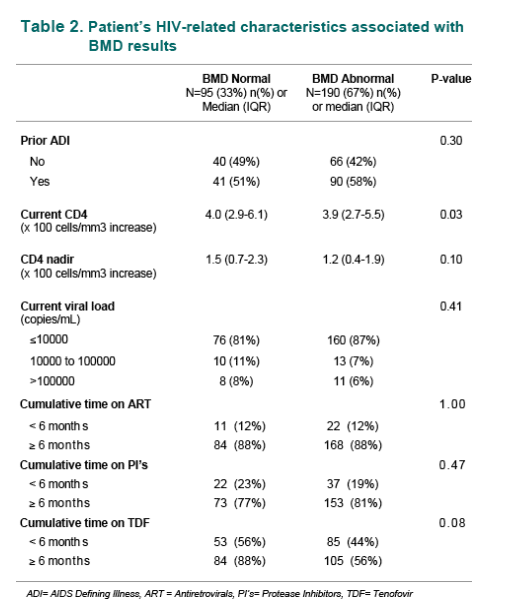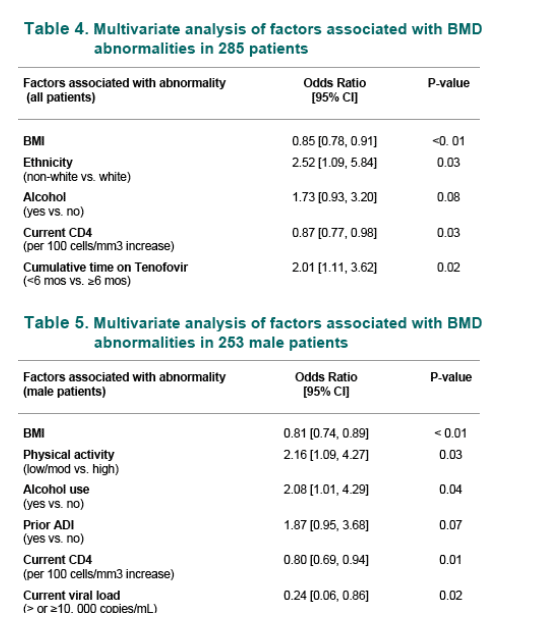 |
 |
 |
| |
Risk Factors for Reduced Bone Mineral Density In HIV-Infected Individuals In The Modern HAART Era
|
| |
| |
67% reduced BMD, 54% osteopenia; average age 49 yrs; authors recommend HIV+ be monitored closely for bone abnormalities (I presume they mean bone DEXAs)-this is one of several AT CROI recommending monitoring.
Reported by Jules Levin
15th CROI, Feb 3-6, 2008, Boston
Silvia Guillemi, F Ng, W Zhang, V Lima, C Rocha, M Harris, G Bondy, A Belzberg, J Montaner
British Columbia Centre for Excellence in HIV/AIDS, Providence Health Care and the University of British Columbia, Vancouver, Canada
Background
Reduced bone mineral density (BMD) has been frequently reported among HIV infected individuals receiving antiretroviral therapy (ART). Brown et al. (AIDS 2006,20:2165-2174) reported a three-fold increased prevalence of osteoporosis and a 2.5-fold higher prevalence of reduced BMD among ART treated vs. naive HIV-infected individuals.
Multiple factors have been postulated to increase the risk for osteoporosis and reduced BMD, including HIV infection and use of ART.
We conducted a prospective cross-sectional study to evaluate the frequency and factors associated with decreased BMD, osteopenia and osteoporosis among HIV infected individuals.
Author Discussion
We found a 67% prevalence of abnormal BMD by DEXA scan in an unselected group of HIV+ individuals who attended an ambulatory HIV clinic between January 2005 and July 2007. Of those 54% had osteopenia and 13% osteoporosis. Risk factors associated with decreased BMD included low BMI caucasian ethnicity and low CD4 cell count. Among men, additional risk factors included low physical activity, alcohol consumption and high pVL. The results of our analyses did not confirm previously reported associations between low BMD and duration of exposure to ART or exposure to PI's. In contrast, we found a statistically significant association between low BMD and duration of exposure to tenofovir. The mechanism behind this association could not be uncovered in these analyses. Of note, adherence to ART, an important potential confounder, was not adjusted for in these analyses.
Author Conclusion
Our results support the recommendation that HIV infected individuals be closely monitored for bone density abnormalities. Further prospective evaluation of the possible contribution of tenofivr-containing ART to the development of low BMD is warranted based on our findings.
Abstract
Objective: High prevalence of osteopenia and osteoporosis has been described in HIV+ patients. A possible association with HAART remains controversial. We conducted a prospective study to identify factors associated with reduced bone mineral density (BMD) among HIV+ individuals.
Methods: Consenting ambulatory HIV+ adults were enrolled. All participants
completed a detailed questionnaire and a dual-energy X-ray absorptiometry
(DEXA) scan of lumbar spine and femoral neck. Full laboratory and HAART-related information were also obtained. Osteopenia and osteoporosis were diagnosed according to the WHO criteria. Logistic regression analysis was performed in both unvaried and multivariate setting to investigate factors associated with abnormal BMD.
Results: 285 patients completed the study from Jan 2005 to Jul 2007; 79%
were Caucasian and 89% male. Median age was 48 years [IQR: 43 - 55].
A full 67% of patients had abnormal DEXA scans with osteopenia in 54% and osteoporosis in 13%.
Using an Akaike's information criterion (AIC) model selection approach, the multivariate analysis confirms that low BMI, Caucasian ethnicity, and current low CD4's count were risk factors related to low BMD.
Low physical activity, alcohol consumption and current high pVL were also significantly associated with low BMD among men.
There was no correlation between abnormal BMD and any metabolic or laboratory parameters evaluated. When ART drugs were explored, Tenofovir (TDF) exposure (but not PI exposure or total ART exposure) was associated with
low BMD (OR 1.56, p < 0.08). The mechanism behind this association could not be elucidated within this analysis.
Conclusions: We found a 67% prevalence of abnormal BMD by DEXA scan in an unselected group of HIV+ individuals. Risk factors for low BMD included those observed in the normal populations (low BMI, Caucasian ethnicity and lower physical activity) and others related to advanced HIV illness (low CD4 count). An association was also uncovered with longer exposure to Tenofovir; this merits further study.
Methods
Consenting HIV positive adults attending the Immunodeficiency Clinic (IDC) at
St. Paul's Hospital (Vancouver, BC, Canada) were enrolled. The following parameters were obtained in all patients:
· Detailed life style and medical history questionnaire.
· Dual-energy X-ray absorptiometry (DEXA) scan of lumbar spine and femoral neck. Osteopenia and osteoporosis were diagnosed according to the WHO criteria .
· Full laboratory, including: 24-hour urinary calcium, and urinary Ntelopeptide, Alkaline Phosphatase, Ionized calcium, phosphorus, serum testosterone (total and bioavailable), TSH, PTH, CD4 count, plasma HIV RNA level.
· Complete ART exposure history was obtained through a linkage with the British Columbia Centre for Excellence in HIV-AIDS (BC-CfE) database. The BC-CfE Drug Treatment Program is responsible for the distribution of free antiretrovirals to all BC residents
Logistic regression analysis was performed in both univariate and multivariate settings to investigate factors associated with decreased BMD, osteopenia and osteoporosis.
Results
As shown in Table 1, a total of 299 patients were enrolled and 285 completed the study between Jan 2005 and Jul 2007; 80% were Caucasian and 89% male. Median age was 48 years [IQR: 43 - 55 years]. A total of 67% of patients had an abnormal BMD. Patients with an abnormal BMD had a statistically lower body mass index (BMI) (p<0.01), and had higher rates of alcohol use (p = 0.01).


As shown in Table 3, 67% (n= 190) of patients had abnormal DEXA scans. Of those, 54% (n=152) had osteopenia and 13 % (n= 38) had osteoporosis according to the WHO criteria.

Multivariate Analyses
The multivariate analysis confirms that low BMI, ethnicity (Caucasian), and current low CD4's count were associated with lower BMD (p <0.03) (Table 4)
Low physical activity, alcohol use, and current high plasma viral load (pVL) were also significantly associated with low BMD among men only (p<0.03)(Table 5).
When we analyzed time of exposure to total ART' , by drug class (PI's only), or to Tenofovir (TDF)specifically; we observed that only TDF exposure of more than 6 months was associated with lower BMD (p< 0.02).
There was no correlation between low BMD and any metabolic or laboratory parameters, concomitant medications (including corticosteroids or anabolic steroids), family history, or duration of HIV infection.

|
| |
|
 |
 |
|
|